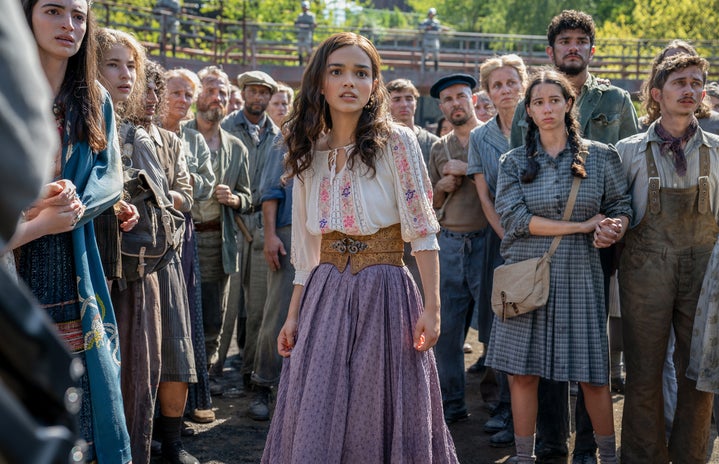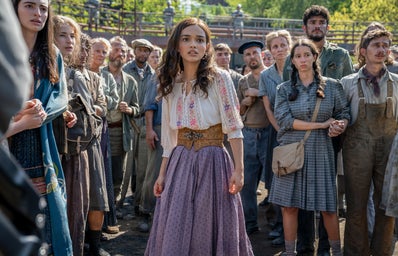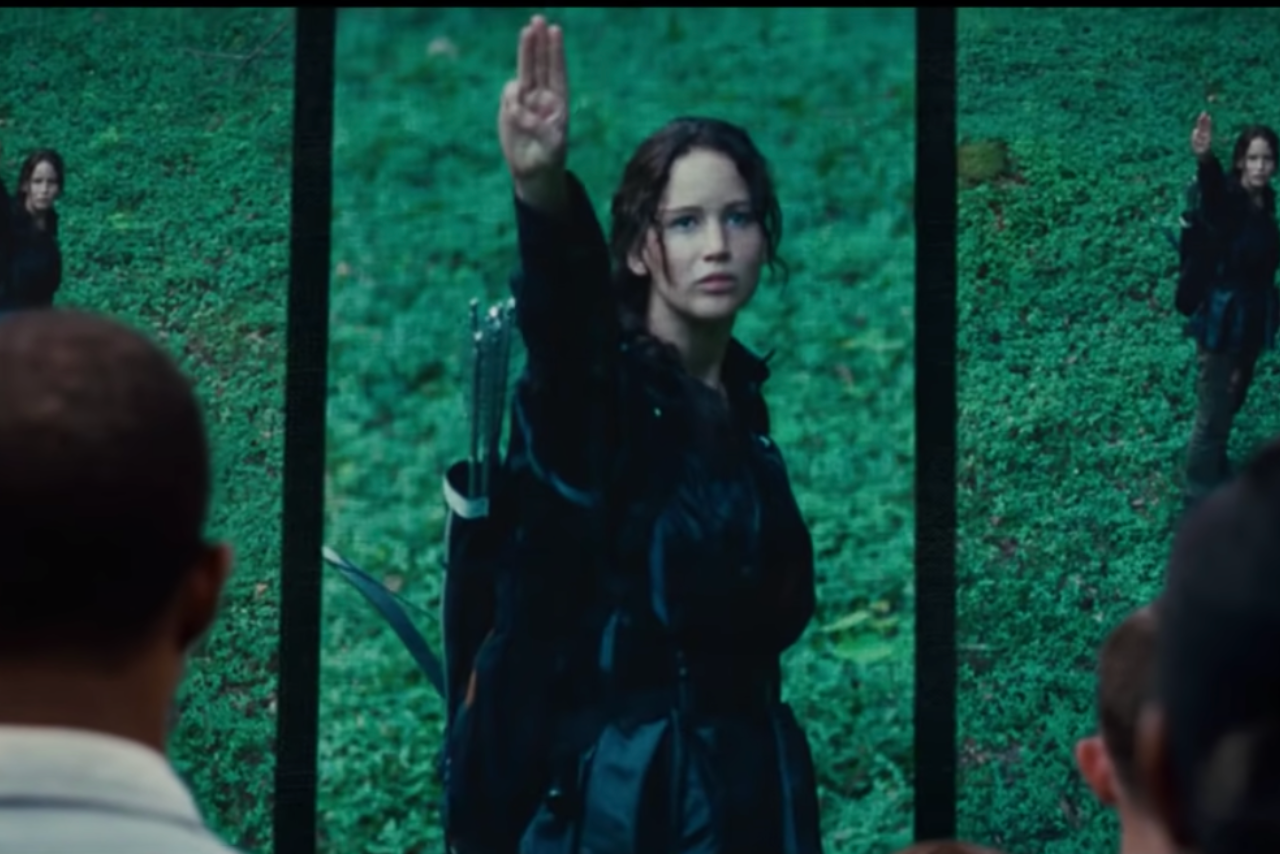Spoiler warning: this article contains lots of spoilers for the Hunger Games books and movies, including the new book and movie “A Ballad of Songbirds and Snakes.”
I love the Hunger Games trilogy.
I read the original trilogy when I was in eighth grade, and then reread it again and again. “Catching Fire” is my favorite movie, and I’ve probably watched it a hundred times, but I don’t think I’ll ever get sick of it.
This summer, I read “A Ballad of Songbirds and Snakes” in about a day and loved every second of it. On Friday, November 17, I went to the movies with a bunch of friends to see the premiere of the movie, and it was truly an incredible book-to-movie adaptation.
For anyone who doesn’t know, “A Ballad of Songbirds and Snakes” is a prequel to the Hunger Games trilogy, set 64 years earlier during the tenth annual Hunger Games. Since people were losing interest in the Hunger Games, top Capitol academy prospects were assigned to be mentors to the tributes, and to turn them into something more entertaining than just children plucked from the Districts to kill each other. One of these mentors was Coriolanus Snow, the future tyrannical president of Panem.
Originally, I planned on writing an article comparing and contrasting the book and movie, but to be honest, there wouldn’t be much to talk about. The movie was an incredible adaptation of the book that I felt captured all of the most important parts of the novel.
The main difference was the Games themselves. In the book, the mentors could not see any of the tributes once they went down into the tunnels. Clearly, the future Gamemakers learned from this and started adding cameras everywhere. However, adding cameras in the tunnels for the movie made sense cinematically. It would have made for a very boring movie if we as an audience just had to sit there watching nothing happening in the arena.
I only had two qualms with the movie. My first qualm was the scene where Arachne was stabbed in the neck with a bottle by her tribute. I was fine with the switch from the knife to the bottle, but I did not love how in the movie Coriolanus ran straight over without hesitation to help her.
I thought that in the book, when Lucy Gray had to tell him to help, and he did so only to look good in front of the cameras, it revealed an important part of his character. He wanted to look like a good person, he would take the praise for acting like a good person, and he would even claim to be the friend of a girl he hated once she died in order to receive the glory and attention for his heroism and the pity for the loss of his “friend.” However, he was never actually brave or a good person. He did not naturally care enough to help this girl, but was inspired by a genuinely good person who he wanted to impress.
My second qualm is what happened with Clemensia’s entire storyline. In the movie, we never got to see what even one small bite from one of the snakes can do to somebody. In the book, I thought Clemensia’s condition and the way her personality changed after the bite was a huge indication of just how evil Dr. Gaul and her creations are. It showed the kind of horrors the Capitol was okay with using against children as early as the 10th Hunger Games, and how it got to be so horrible by the 74th and 75th Hunger Games with Katniss and Peeta.
Aside from these, I thought that any diversion the movie made from the book only served to enhance the storyline for movie watchers. I was thrilled with the acting, songs, costumes and plot, and I thought that the movie was incredible.
I watched “A Ballad of Songbirds and Snakes” in the theater on Friday, and on Sunday my boyfriend and I had a Hunger Games marathon to kick off our first day of Thanksgiving Break. After comparing the prequel to the original books and movies, I’ve compiled a list of my favorite parallels between President Snow’s teenage years and Katniss and Peeta’s.
Reaper’s Graveyard and Katniss’s Memorial for Rue
I loved how even as early as the 10th Hunger Games, tributes were rebelling against the Capitol simply by showing compassion for the people they were expected to see as competition.
Reaper creating a graveyard, not only for his ally, but also every other tribute that had died in the Games so far, then covering their bodies with the Capitol flag, was just as much of a rebellious act as fighting in the actual rebellion. The parallel between him covering the other children with the flag and Katniss singing to Rue, closing her eyes, and covering her body with flowers was beautiful.
The Meadow and the Lake in District 12
I loved that the meadow and the lake from Katniss’s time were also important to Lucy Gray and her family. I have seen multiple fan theories questioning if Katniss’s father might be related to the Covey, and this is one of the best pieces of evidence for it.
The lake where Katniss learned to swim and the cabin where she fed rebel escapees, Bonnie and Twill, on their way to District 13 were both outside the fence of District 12, isolated and would be difficult for most civilians to find.
The fact that Katniss’s father knew where the lake and cabin were and showed them to his daughter is great evidence that he may have had a Covey parent show him before. This, in addition to both Katniss and her father’s love of singing, is great evidence that they may be related to the Covey.
The Train from the Districts to the Capitol
I thought it was so interesting to see the difference in the tributes’ treatment from the 10th annual Games to Katniss and Peeta’s 74th annual games. The train was one of the most stark differences.
In Katniss and Peeta’s games, the train is the epitome of luxury. Katniss and Peeta are served delicious food, given gigantic, beautiful bedrooms and it moves quickly from the Districts to the Capitol.
In the tenth annual Games, tributes were shoved into a dark, dirty livestock car filled with bats, given no food and had to suffer the whole way to the Games. One of the tributes, Jessup, was bitten by a bat and ended up with rabies in the Games.
The train is an excellent metaphor for how the Capitol functioned under Snow’s reign. He made the Capitol look welcoming and generous for the tributes, romanticizing the Games and encouraging Capitol viewership.
However, he was still forcing children to murder other children to control the Districts. This is who Snow always was: motivated by a need to be perceived as good, not to actually be a good person.
Sponsorships
Young Snow’s idea of allowing betting and sponsors revolutionized the Games. Before sponsors, the only way to win the Games was through brute strength. It genuinely was a hunt. However, once sponsors became a part of the fabric of the Games, the Games became a performance. Tributes needed to gain the approval of Capitol citizens for even a chance of survival.
Unwittingly, Snow also paved the way for tributes from poorer districts like District 12 to win in the future because of his own desire for self-preservation and his pride. When he made it a rule that mentors could not donate to their own tribute to win, he was only trying to hide the fact that he had no money to fund Lucy Gray’s food or water.
However, by doing this, he guaranteed that Career tributes and tributes from poorer districts were on the same playing field when it came to sponsorships: as long as they could garner support from the public, they could receive life-saving medicine, food, and water.
It was because of this rule that Katniss and Peeta were able to win the Games and go on to fight in the rebellion against Snow.
When Lucy Gray Showed Katniss to Coriolanus
This was just a great nod to the original series, and also goes to support the fan theory that Katniss’s father was related to a member of the Covey. It’s also just sort of funny that Katniss’s name means “swamp potato” while her sister was named after a flower.
In general, I thought that the parallels between Katniss and Lucy Gray were very interesting. They were both young girls, from District 12, singers and fiercely protective of their families.
I loved one comparison I saw on TikTok: Katniss was a hunter forced to perform, and Lucy Gray was a performer forced to hunt. In general, I love that the two characters were very different protagonists with a few similarities.
The Tributes’ Pre-Games Timeline
The effort that was put into the Games was so different from the 10th to the 74th. Katniss and Peeta were given weeks of training, food, luxurious living accommodations, and interviews. They were being taken care of and prepared for a performance.
In the 10th annual Hunger Games, tributes were dropped into a cage at the zoo, starved, suffered through a bombing and were still forced to fight in the arena. In the 74th annual Hunger Games, the tributes were valuable assets to the Capitol. In the 10th Games, only 14 of the original 24 tributes are still alive when the Games begin.
Capitol Nepo Babies
There were many familiar last names dropped throughout the movie and book. Caesar Flickerman took the job of hosting the Hunger Games from his predecessor, Lucky Flickerman. Hilarious Heavensbee acts as Wovey’s mentor in the games, and we can only assume that he is the father of future Gamemaker and rebel leader Plutarch Heavensbee from the original Hunger Games series.
Despite being poor during the 10th Games, Coriolanus Snow is able to get by with the power of his father’s last name. Clearly, old money and nepotism play an important role in the structure of the Capitol.
Tigris
I would love to see a timeline of how Tigris went from Snow’s adoring cousin to a woman who modified her body to the point of being unrecognizable, was fired by her own cousin, harbored rebels and wanted Snow dead. She is such an interesting character that I would love to know more about.
The Mockingjays
Snow’s hatred of the Mockingjays as early as the 10th Games makes the symbolism of the Mockingjay in Katniss’s story that much better. He hated that the Capitol couldn’t control them, just like he hated that the Capitol couldn’t control Katniss or the Districts.
The Hanging Tree
This was my favorite parallel between “A Ballad of Songbirds and Snakes” and “The Hunger Games.” The fact that the song the rebels used while ruining Snow’s life was the song that his ex-girlfriend wrote is amazing.
I remember reading the books in middle school and wondering what on earth the line “where a dead man called out for his love to flee” actually meant. Finding out that the jabberjays echoed Arlo’s last words for minutes after he died is so creepy and adds such an eerie extra layer to the song, especially knowing that they did the same thing when Sejanus was hung at Snow’s hand.
Knowing how angry Snow must have been hearing Katniss sing Lucy Gray’s song makes it so much cooler. I love Suzanne Collins and her brain so much.
Thanks for reading, and may the odds be ever in your favor.



